Who were the Moguls?
The new moguls were brash, uneducated, and intellectually unsophisticated. But they understood that film was about audiences and stories, not film-stock and equipment.
Virtually all of them were born into extreme poverty. Virtually all of them were Jewish. Virtually all were either immigrants themselves or the sons of immigrants. There were deep connections among them; both family ties and business ties.
The fought with each other frequently and bitterly, undercutting each other, making secret deals with one another, forcing one another from the business. But they also allied with and supported each other when the need arose.
Movies played a critical role in forming America's vision of itself in the 20th century. But the movie vision of America was, in many ways, an immigrant vision; formed of immigrant dreams and ideas of what America should be.
On this page we examine some of the personalities behind M-G-M, Metro Goldwyn Mayer.
Metro Pictures was formed in 1915 as an alliance between three film exchange and theater owners: Richard Rowland from Pittsburgh, who headed the firm; George Grombacher from Portland OR, manager of the Western Film Exchange, and Louis B. Mayer from Boston. Metro originated to supply films for the exchanges and and theaters of its owners. Metro established a studio in Los Angeles and began to produce films.
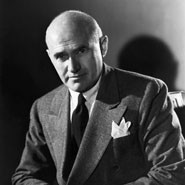 Goldwyn Pictures was founded in 1916 by Samuel Goldfish (pictured left) and the Broadway producers Edgar and Archibald Selwin. Goldfish liked the name Goldwyn so much that he made it his own. The M-G-M lion was originally the trademark of Goldwyn Films.
Goldwyn Pictures was founded in 1916 by Samuel Goldfish (pictured left) and the Broadway producers Edgar and Archibald Selwin. Goldfish liked the name Goldwyn so much that he made it his own. The M-G-M lion was originally the trademark of Goldwyn Films.
Samuel Goldwyn (1879-1974) born Szmuel Gelbfisz, in Warsaw, was one of the great personalities of the early movie industry. An immigrant via England and Canada, Gelbfisz worked as a glover (leather glove maker) in upstate New York. Arriving in the English speaking world, he anglicized his name as Samuel Goldfish. In 1913, he joined his brother-in-law, Jesse Lasky to go into the movie business. Their new company was called the Feature Play Company. Later they were joined by Adolph Zukor (1883-1976) who had a company called Famous Players and the name was changed changing the name to Famous Players Lasky, which eventually become Paramount. However, Gelbfisz was forced out. He formed a new company, Goldwyn Pictures, with the Selwyn brothers (NYC theater producers, as noted above). Goldwyn pictures had some significant successes but also difficulties and in 1922, Goldwyn was forced out of this company as well (However, he liked the Goldwyn name so much that he took it for his own.). In 1923, he formed his own company Samuel Goldwyn Productions which became a critical part of United Artists, survived until 1959 and made many famous films including The Best Years of our Lives (1946), The Secret Life of Walter Mitty (1947) and Guys and Dolls (1955). During his lifetime, Goldwyn was the most successful independent movie producer in the US. Goldwyn's son, Samuel Goldwyn Jr (1926-2015), continued the legacy, founding The Samuel Goldwyn Company and Samuel Goldwyn Films. Goldwyn's grandson, Tony Goldwyn (1960-) is a well known actor, playing, among other things, Fitzgerald Grant III on Scandal (2012-2018).
Goldwyn was famous for accidental or intentional witticisms. There are many he said and many falsely attributed to him (but that is also important). Some examples: An oral contract isn't worth the paper it's written on. Give me a couple of years, and I'll make that actress an overnight success. You've got to take the bull between your teeth. Never make forecasts, especially about the future. I don't think anyone should write his autobiography until after he's dead. On a set, Goldwyn once asked a director: Why is everything so dirty here?" He was told that it was supposed to be a slum, Goldwyn responded, "Well, this slum cost a lot of money. It should look better than an ordinary slum."
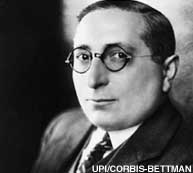 Louis B. Mayer Pictures was founded by Louis B. Mayer (1884-1957, pictured left) , who had also been a principle of Metro Pictures. Mayer was a Russian immigrant and scrap metal dealer who grew up in St. John, New Brunswick. Mayer purchased a burlesque house in Haverhill MA which he turned into a movie theater. He then started a film exchange. Mayer's big break was acquiring exclusive rights to show Birth of a Nation in New England. He used the money from this to join Metro Pictures. However, his association with Metro only lasted a couple of years. In 1918, he started his own studio, Louis B. Mayer Pictures. This expanded a few years later due to a partnership with another theater owner, B. P. Schulberg. Together, in 1920, they formed the Mayer-Schulberg Studio.
Louis B. Mayer Pictures was founded by Louis B. Mayer (1884-1957, pictured left) , who had also been a principle of Metro Pictures. Mayer was a Russian immigrant and scrap metal dealer who grew up in St. John, New Brunswick. Mayer purchased a burlesque house in Haverhill MA which he turned into a movie theater. He then started a film exchange. Mayer's big break was acquiring exclusive rights to show Birth of a Nation in New England. He used the money from this to join Metro Pictures. However, his association with Metro only lasted a couple of years. In 1918, he started his own studio, Louis B. Mayer Pictures. This expanded a few years later due to a partnership with another theater owner, B. P. Schulberg. Together, in 1920, they formed the Mayer-Schulberg Studio.
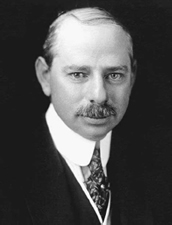 So, where does M-G-M come from? Well, from a guy whose name is not on the marquee: Marcus Loew (1870-1927), (pictured left). Loew, the son of Polish immigrants, grew up poor in New York City and held a series of menial jobs in men's clothing and then in the fur industry. He went bankrupt several times but eventually was successful. This brought him into contact with another furrier, Adolph Zukor and both, looking for greater success, went first into owning penny arcades, then into owning vaudeville theaters, and then into owning movie theaters (Any movie theater today called Loew's, AMC, or Odeon is probably a descendent of Loew's original company). As we have seen, it was a short leap from movie theater ownership to studio ownership. Loew, in 1919, bought Metro Pictures (recall that Mayer had been one of the founders of Metro...but he had left the company in 1918). In 1924, he acquired Goldwyn Pictures (But recall that Goldwyn had been forced out in 1922). So, Loew had two film studios but but no one to really run them. This led to his acquisition of Mayer-Schulberg Studios (the company Mayer had formed after he left Metro and where he actually did work), largely to acquire Louis B. Mayer. Thus, M-G-M was formed.
So, where does M-G-M come from? Well, from a guy whose name is not on the marquee: Marcus Loew (1870-1927), (pictured left). Loew, the son of Polish immigrants, grew up poor in New York City and held a series of menial jobs in men's clothing and then in the fur industry. He went bankrupt several times but eventually was successful. This brought him into contact with another furrier, Adolph Zukor and both, looking for greater success, went first into owning penny arcades, then into owning vaudeville theaters, and then into owning movie theaters (Any movie theater today called Loew's, AMC, or Odeon is probably a descendent of Loew's original company). As we have seen, it was a short leap from movie theater ownership to studio ownership. Loew, in 1919, bought Metro Pictures (recall that Mayer had been one of the founders of Metro...but he had left the company in 1918). In 1924, he acquired Goldwyn Pictures (But recall that Goldwyn had been forced out in 1922). So, Loew had two film studios but but no one to really run them. This led to his acquisition of Mayer-Schulberg Studios (the company Mayer had formed after he left Metro and where he actually did work), largely to acquire Louis B. Mayer. Thus, M-G-M was formed.
Mayer was the only one of these founders who was active in the operation of the studio and whose name was part of the studio name. And, Mayer became one of the most famous, successful, and feared of the Hollywood studio bosses (when you see parodies or other representations of tyrannical studio bosses, they are often based on Mayer). He became quite wealthy and lived very well. HOWEVER, Mayer had no ownership in the studio that bore his name. He was an employee of Marcus Loew, and after Loew's death in 1927, an employee of Loew's partner, Nicholas Schenck (1880-1969, born in Rybinsk, Russia), Schenck and his brother Joseph had been successful at selling beer at vaudeville theaters. Loew loaned them money to start the Palisades Amusement Park in NJ and after that was successful, brought Nicholas Schenck into his movie business as his second in charge). Loew and Schenck were the real powers, not Mayer. In 1951, Mayer was forced out of MGM after fights with Loew's. He died of leukemia six years later.
And what happened to M-G-M after it included neither Metro nor Goldwyn, nor Louis B. Mayer? Well, it's extremely complicated but Loew's Inc. held control of M-G-M only until 1954 when they sold the M-G-M studio but kept the Loew's theater chain. Since then M-G-M has had a series of owners including Edgar Bronfman of Segrams, Kirk Kerkorian, a Las Vegas casino owner, Ted Turner, Giancarlo Peretti and Credit Lyonais, and then Kirk Kerkorian again. From 2005 to 2022, it was owned by MGM Holdings, and until 2018 led by Gary Barber, one of the founders of Spyglass entertainment. Much of Barber's fortune seems to have come from horse racing. Several people chaired the company after Barber. Then, in 2022 it was sold to Amazon and today operates as Amazon MGM Studios.
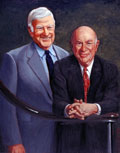 And what happened to Loew's? It began to take its current form in 1959 when Laurence and Robert Tisch (pictured left) purchased the Loew's theater chain. They begin to build Loew's into an extremely complex international holding company that has included at various times Lorillard Tobacco, CNA Financial, Bulova Watch, CBS, Gulf South Pipeline, Diamond Offshore Drilling, and Loew's hotels. However, Loew's left the movie theater business in 1985 and since then the theaters have been through a variety of ownerships. Today Loew's theaters still exist but they are part of a large company that includes AMC theaters. The majority shares in this company were owned by the Dalian Wanda Group, headquartered in Beijing, but they sold in 2021. These theaters and the name Loew's have been bought and sold so often it's hard to know who owns exactly what, but AMC is a publicly traded stock and the largest shareholders are mutual funds and investment banks. At any rate, Marcus Loew would probably be proud. Though company that bears his name has nothing to do with the movie theaters, movie production (or fur...remember, that's where he started), it has assets of about $80 billion.
And what happened to Loew's? It began to take its current form in 1959 when Laurence and Robert Tisch (pictured left) purchased the Loew's theater chain. They begin to build Loew's into an extremely complex international holding company that has included at various times Lorillard Tobacco, CNA Financial, Bulova Watch, CBS, Gulf South Pipeline, Diamond Offshore Drilling, and Loew's hotels. However, Loew's left the movie theater business in 1985 and since then the theaters have been through a variety of ownerships. Today Loew's theaters still exist but they are part of a large company that includes AMC theaters. The majority shares in this company were owned by the Dalian Wanda Group, headquartered in Beijing, but they sold in 2021. These theaters and the name Loew's have been bought and sold so often it's hard to know who owns exactly what, but AMC is a publicly traded stock and the largest shareholders are mutual funds and investment banks. At any rate, Marcus Loew would probably be proud. Though company that bears his name has nothing to do with the movie theaters, movie production (or fur...remember, that's where he started), it has assets of about $80 billion.
Back to The New Moguls
![]() A personal note (NOT required reading!): I have no current connection to Hollywood at all. However, in the first half of the 20th century, various members of my extended family did. My grandmother was a friend of Mildred Zukor, daughter of the founder of Paramount, who married (then later divorced) Arthur Loew, the son of Marcus Loew. Jules and Etta Mastbaum were slightly more distant relatives. Mastbaum was an early 20th century theater magnate (he owned the Stanley Theater chain, named after his older brother, who had died at the age of 38. After Jules' death Stanley was sold to Warner Brothers, which continued to use the name. So, for example, Luling TX had a Stanley Theater (the building is still standing but hasn't been a theater for a long time). It was named after my relative, but wasn't part of the original chain). The Mastbaum Theater in Phila was one of the largest in the nation. Lesser Samuels, a screenwriter who worked with Billy Wilder and Frank Loesser (who was also a friend of my grandmother) was my 3rd cousin. According to my father, Samuels pressured my grandparents to move to LA in the 1930s. Had they done so, my father would have almost certainly ended up in the business (but would never have met my mother). J. David Stern III was another 3rd cousin. He was, among other things, the author of all seven of the Francis the Talking Mule films from the 1950s. Francis was the forerunner of Mr. Ed. Oh, yeah, and another distant relative (who I've never actually met) supposedly lives in a Hollywood house once owned by Marilyn Monroe and Joe DiMaggio. All this and $5 will buy me a cup of coffee, but it's kind-of fun.
A personal note (NOT required reading!): I have no current connection to Hollywood at all. However, in the first half of the 20th century, various members of my extended family did. My grandmother was a friend of Mildred Zukor, daughter of the founder of Paramount, who married (then later divorced) Arthur Loew, the son of Marcus Loew. Jules and Etta Mastbaum were slightly more distant relatives. Mastbaum was an early 20th century theater magnate (he owned the Stanley Theater chain, named after his older brother, who had died at the age of 38. After Jules' death Stanley was sold to Warner Brothers, which continued to use the name. So, for example, Luling TX had a Stanley Theater (the building is still standing but hasn't been a theater for a long time). It was named after my relative, but wasn't part of the original chain). The Mastbaum Theater in Phila was one of the largest in the nation. Lesser Samuels, a screenwriter who worked with Billy Wilder and Frank Loesser (who was also a friend of my grandmother) was my 3rd cousin. According to my father, Samuels pressured my grandparents to move to LA in the 1930s. Had they done so, my father would have almost certainly ended up in the business (but would never have met my mother). J. David Stern III was another 3rd cousin. He was, among other things, the author of all seven of the Francis the Talking Mule films from the 1950s. Francis was the forerunner of Mr. Ed. Oh, yeah, and another distant relative (who I've never actually met) supposedly lives in a Hollywood house once owned by Marilyn Monroe and Joe DiMaggio. All this and $5 will buy me a cup of coffee, but it's kind-of fun.
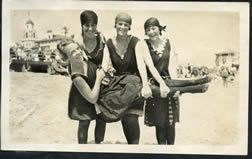 My grandmother (horizontal) and "Mickey" Zukor (far right) on the beach in 1918.
My grandmother (horizontal) and "Mickey" Zukor (far right) on the beach in 1918.